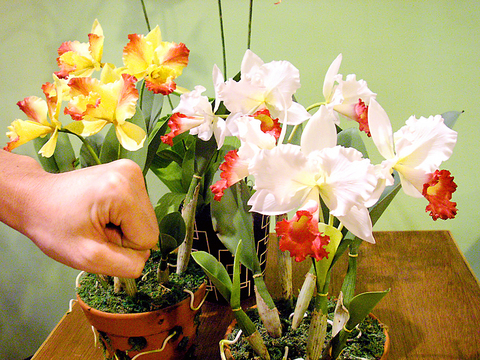Located in Taipei's bustling Shida Night Market (
Sitting in her shop, Lin works at a table making miniature models of vegetables, bread, and bacon, each the size of a finger nail.
"This was commissioned by a nutritionist," she said. "She wants to use these as teaching aids to show diabetic sufferers how to eat healthily. Pictures are boring, my work attracts the eye and leaves a stronger impression."

PHOTO: GINGER YANG, TAIPEI TIMES
Lin works in resin; a strong and pliable material. All her works look almost exactly like the real thing. The resin, even after it is dry, has a soft feel, and the leaves and petals of her miniature plants bend under the touch.
Her work is largely inspired by the world she sees around her. It is quite different from the Miniatures Museum of Taiwan (
These small stands bring to mind the boisterous market: the shimmering greasy food, fresh fish laid on ice, and colorful tropical fruit.
Her favorite theme is flowers, such as orchids and tulips. These are the same size as the real plant, and from stem to petal are made of resin.
"The resin I use is a new product. It's soft and flexible so that my artwork is not fragile. Also, as it has a semi-transparent quality, it has the watery glow of a living thing," Lin said.
Displayed beside the flowers are vivid sculptures of dogs, cats and frogs. These sculptures are often ordered by pet owners, sometimes as a memorial to animals that have died. For these, Lin works from photographs.
While many may think that the skills of the miniaturist are hard to acquire, Lin said she took to the work very easily. Her first work, a bowl of lotus flowers, took her 14 days to complete, and is on display in the store.
Meeting with such success, she decided to dedicate herself to creating miniatures and models for the next two years, after which she opened her first shop.
"I do this for my own interest. Making beautiful things always gives me a feeling of serenity," said Lin. "I don't care about making a profit out of it."

The canonical shot of an East Asian city is a night skyline studded with towering apartment and office buildings, bright with neon and plastic signage, a landscape of energy and modernity. Another classic image is the same city seen from above, in which identical apartment towers march across the city, spilling out over nearby geography, like stylized soldiers colonizing new territory in a board game. Densely populated dynamic conurbations of money, technological innovation and convenience, it is hard to see the cities of East Asia as what they truly are: necropolises. Why is this? The East Asian development model, with

June 16 to June 22 The following flyer appeared on the streets of Hsinchu on June 12, 1895: “Taipei has already fallen to the Japanese barbarians, who have brought great misery to our land and people. We heard that the Japanese occupiers will tax our gardens, our houses, our bodies, and even our chickens, dogs, cows and pigs. They wear their hair wild, carve their teeth, tattoo their foreheads, wear strange clothes and speak a strange language. How can we be ruled by such people?” Posted by civilian militia leader Wu Tang-hsing (吳湯興), it was a call to arms to retake

This is a deeply unsettling period in Taiwan. Uncertainties are everywhere while everyone waits for a small army of other shoes to drop on nearly every front. During challenging times, interesting political changes can happen, yet all three major political parties are beset with scandals, strife and self-inflicted wounds. As the ruling party, the Democratic Progressive Party (DPP) is held accountable for not only the challenges to the party, but also the nation. Taiwan is geopolitically and economically under threat. Domestically, the administration is under siege by the opposition-controlled legislature and growing discontent with what opponents characterize as arrogant, autocratic

When Lisa, 20, laces into her ultra-high heels for her shift at a strip club in Ukraine’s Kharkiv, she knows that aside from dancing, she will have to comfort traumatized soldiers. Since Russia’s 2022 invasion, exhausted troops are the main clientele of the Flash Dancers club in the center of the northeastern city, just 20 kilometers from Russian forces. For some customers, it provides an “escape” from the war, said Valerya Zavatska — a 25-year-old law graduate who runs the club with her mother, an ex-dancer. But many are not there just for the show. They “want to talk about what hurts,” she